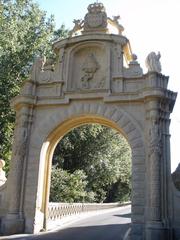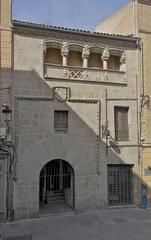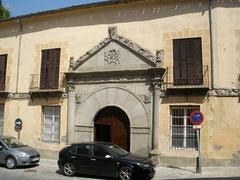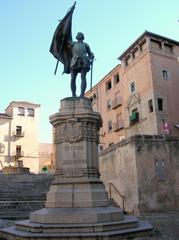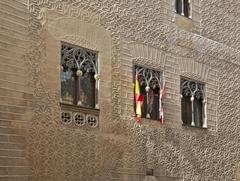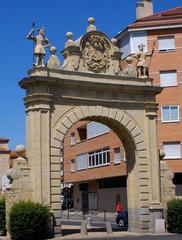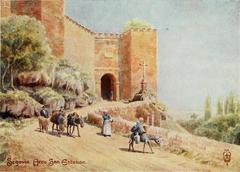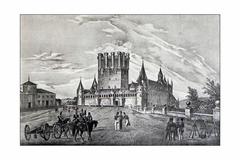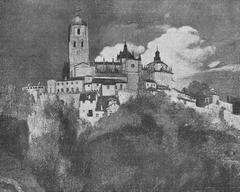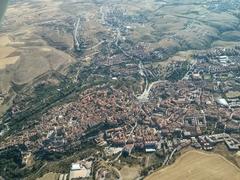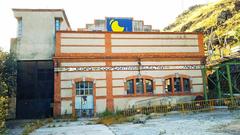Visiting the Monastery of Santa María del Parral (Segovia, Spain): Tickets, Hours, and Essential Visitor Tips
Date: 04/07/2025
Introduction
The Monastery of Santa María del Parral, located just outside Segovia’s ancient walls, is a remarkable example of Spain’s medieval monastic and architectural heritage. Founded in 1447 by King Henry IV of Castile, this former Hieronymite monastery is celebrated for its harmonious blend of Gothic, Mudéjar, Plateresque, and Renaissance styles. Perched beside the Eresma River, it offers panoramic vistas of Segovia’s historic skyline, including the iconic Alcázar and cathedral (Monastery of Santa María del Parral: Visiting Hours, Tickets & Historical Guide in Segovia; Monastery of Santa María del Parral: Architectural Marvel and Visitor’s Guide to a Segovia Historical Site).
Historically, the monastery is intertwined with royal patronage and noble influence, most notably the Marquis of Villena, Juan Pacheco. Over the centuries, it has served as a spiritual sanctuary, endured periods of abandonment, and undergone significant restoration (Visiting Monasterio de Santa María del Parral: Hours, Tickets, History, and Cultural Significance in Segovia). Today, it remains a living monastery, where visitors can experience centuries-old traditions, explore architectural treasures, and enjoy a peaceful atmosphere preserved by the resident monastic community (Monastery of Santa María del Parral Visiting Hours, Tickets & Guide to Segovia Historical Sites).
Table of Contents
- Historical Overview
- Practical Visitor Information
- Notable Events and Figures
- Frequently Asked Questions (FAQ)
- Conclusion and Recommendations
- References
Historical Overview
Foundation and Origins
Established in 1447 by King Henry IV of Castile, the Monastery of Santa María del Parral was built on the site of the former Hermitage of Nuestra Señora del Parral, located in Segovia’s San Lorenzo district along the Eresma River (es.wikipedia; en.wikipedia). The project received substantial royal and noble patronage, especially from Juan Pacheco, Marquis of Villena. Their heraldic symbols still adorn many parts of the complex (spain.info).
Originally established for the Order of Saint Jerome (Hieronymites), the monastery quickly became a major spiritual and artistic center, reflecting the prestige of its founders and the importance of monastic life in medieval Castile.
Architectural Highlights
Construction of the monastery extended from the late 15th to mid-16th centuries, resulting in a unique blend of architectural styles:
- Gothic Elements: The church features a luminous late Gothic nave, ribbed vaults, and a striking apse.
- Mudéjar and Plateresque Influences: Cloisters and auxiliary buildings showcase traditional brickwork, horseshoe arches, and ornate Plateresque decorative motifs.
- Renaissance Features: The main chapel houses a Renaissance altarpiece and the finely sculpted alabaster tombs of the Marquises of Villena (feverup.com; turismodesegovia.com).
The monastery is organized around four cloisters—including the main cloister, guesthouse, infirmary, and porter’s cloister—each reflecting different architectural periods and functions. The lush setting along the Eresma River not only provided spiritual seclusion but also supported economic activity, as seen in the nearby Real Casa de Moneda (Royal Mint) (en.wikipedia).
Cultural and Religious Significance
Santa María del Parral has long served as a spiritual hub for the Hieronymite order, known for its contemplative practices and preservation of Gregorian chant. The monastery houses significant sacred art, including a Renaissance altarpiece, manuscripts, and religious relics. Masses following traditional liturgy are still celebrated, and the community continues age-old monastic customs (monasteryretreatseurope.blogspot.com; turismocastillayleon.com).
Practical Visitor Information
Location and How to Get There
- Address: Calle Parral 2, 40003 Segovia, Spain
- Situated east of Segovia’s city center, the monastery can be reached by car, taxi, local bus, or a scenic 20-minute walk from the Aqueduct or Plaza Mayor through the Eresma River valley (Triphobo). Parking is available but limited during peak hours.
Visiting Hours
- General Opening: Wednesday to Sunday, with guided tours at 11:00 and 17:00. Closed Monday and Tuesday.
- Special Schedules: During Holy Week and religious holidays, hours may vary. Always check the official website or local tourist information for updates.
Tickets and Admission
- Entrance: Guided tours are free of charge; no prior reservation required (Monjes Jerónimos).
- Donations: Donations are appreciated and help support the monastery’s upkeep. Donations can be made in cash or via bank transfer (IBAN: ES43 0049 5568 8122 1004 1491; BIC: BSCHESMM). Tax deductions are possible with visitor details.
Guided Tours and Accessibility
- Guided Tours: Mandatory for all visitors. Tours last about one hour and are led by the monks, offering expert insight into the monastery’s history, art, and spiritual life.
- Languages: Tours are available in Spanish; check in advance for other languages.
- Accessibility: Some areas retain original features that may be challenging for visitors with reduced mobility. Contact the monastery in advance for details.
Special Events and Experiences
-
Mass and Religious Services: Mass is celebrated on Sundays and holy days at 12:00, with special services during major liturgical events (Segovia Turismo). Visitors are welcome to participate.
-
Cultural Events: Occasional concerts, Gregorian chant performances, and spiritual retreats are held. The gardens and cloisters provide peaceful spots for reflection and photography.
-
Facilities: Restrooms are available. No cafés or shops on site, but Segovia’s city center offers ample amenities.
Notable Events and Figures
Royal Patronage and the Marquises of Villena
The monastery’s foundation and growth were closely linked to King Henry IV and Juan Pacheco, Marquis of Villena. Their patronage is visible in the coats of arms and funerary monuments throughout the complex (spain.info).
19th Century Upheavals and Restoration
The Peninsular War and the 1835 Ecclesiastical Confiscations led to looting, abandonment, and periods of decline (turismodesegovia.com; en.wikipedia). Restoration began after the monastery’s declaration as a national monument in 1914. In 1925, the Hieronymite order was re-established, and today, a small community of monks continues its spiritual mission (antonioyrocinante.com).
Frequently Asked Questions (FAQ)
What are the visiting hours?
Wednesday to Sunday, with guided tours at 11:00 and 17:00. Closed Monday and Tuesday. Check the official website for changes.
Do I need to buy tickets?
No tickets are required; guided tours are free. Donations are appreciated.
Are guided tours available?
Yes, all visits are guided by the monks and last about one hour.
Is the monastery accessible for those with mobility challenges?
Some areas may be difficult to access; contact the monastery for details.
Can I take photographs?
Photography is generally allowed outside religious services; confirm with your guide.
Can I attend Mass?
Yes, Mass is open to the public on Sundays and holy days at 12:00.
Are there nearby attractions?
Yes, the Real Casa de la Moneda, Segovia Cathedral, Alcázar, and the Roman Aqueduct are all within walking distance.
Conclusion and Recommendations
The Monastery of Santa María del Parral exemplifies the confluence of Spanish history, art, architecture, and living monastic tradition. Its serene setting, rich heritage, and ongoing spiritual life make it a must-visit when exploring Segovia. Plan your visit around the guided tours, consider attending a Gregorian chant Mass for an immersive experience, and explore nearby landmarks for a comprehensive Segovia itinerary.
To stay updated on events and visitor tips, download the Audiala app and follow official tourism platforms. Support the monastery through donations if you wish to contribute to the preservation of this cultural treasure.
References
- Monastery of Santa María del Parral: Visiting Hours, Tickets & Historical Guide in Segovia
- Monastery of Santa María del Parral: Architectural Marvel and Visitor’s Guide to a Segovia Historical Site
- Visiting Monasterio de Santa María del Parral: Hours, Tickets, History, and Cultural Significance in Segovia
- Monastery of Santa María del Parral Visiting Hours, Tickets & Guide to Segovia Historical Sites
- Segovia Turismo
- Triphobo
- antonioyrocinante.com

